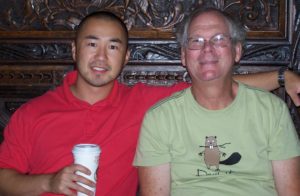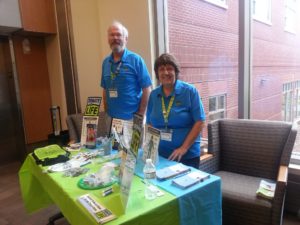The Giver
The Giver
The Tom Rich Story
“Show me someone who has done something worthwhile, and I’ll show you someone who has overcome adversity.”
– Lou Holtz

Everything Tom Rich does is worthwhile. The self-professed “jack-of-all trades” has made his life and his career about giving. Giving himself, his skills, and his time to help others. And all the lives he touches, and the hope he inspires, is because of the adversity he has overcome. Brilliantly.
Life hasn’t been easy for Tom. But he’s used his challenges as a springboard to propel himself, and those around him, forward. At eight years old he became ill with Alport’s Syndrome, a rare and life-long disease that affects the kidneys and can lead to hearing and vision loss. For Tom, Alport’s Syndrome left him with profound hearing loss, from a very young age.
Tom’s formative education years were in the 1960s, not a time where accommodating disabilities was greatly accepted or even practiced. He saw his parents work hard to get his needs for hearing support met in the classroom, and he learned at young age how to be his own advocate.
Healing and Helping
His struggles as a deaf student motivated him to become an elementary school teacher. He knew he could make a difference in the lives of his students both with, and without, disabilities. Tom earned a degree in elementary education, and had the drive and desire to make a difference, but school districts at the time did not want to hire a deaf teacher.

Adapting and Accepting
Undeterred, Tom used his education in a different way, working in private schools helping children with disabilities. While he eventually became a computer programmer and analyst, a career he had for over thirty years, the seeds of helping others, especially children, were firmly planted.
After graduating from college, Tom received his first hearing dog, Sandy, a golden retriever mix, from NEADS (a non-profit that trains service dogs.) With Sandy, everything changed, and his life got so much better.
Tom is quick to say that he didn’t realize how much he couldn’t hear until Sandy came into his life. “I always thought I heard more than I did,” Tom says. With Sandy’s calming presence in his life, Tom was finally able to relax and sleep well at night, knowing she would alert him to a smoke detector or fire alarm.
Sandy was such a good hearing dog that one night she alerted Tom, and his wife Joanne, to a sound she heard. When they went to investigate they found it was two cats fighting in their yard. They had a good laugh, and also great confidence that Sandy was always on duty.
When the NEADS organization asked Tom to speak about his experience with deafness and the support of a hearing dog, Tom’s second career as a lifelong volunteer began.
Speaking and Supporting
Tom began speaking to schools and colleges to educate them on the role service dogs have in education and in the lives of those with disabilities.
One memorable moment was when Tom was invited by his teacher friend, Kathy, to visit her class of deaf students, to share the value of service dogs. While Tom and Sandy were there, Kathy’s college professor from Gallaudet University stopped by the classroom for a surprise visit.
The professor was not impressed with service dogs, and made the comment that service dogs really don’t work. A short while later, during lunch break, a child was in the classroom completing make-up work. When the student finished his work he called Sandy to get Tom’s attention.
Much to the professor’s surprise, Sandy understood the child’s “deaf speech” and alerted Tom to see the child and the completed assignment. Tom says, “That certainly changed the professor’s mind about the value of service dogs. It was a real eye-opener for him.”
Many years ago, after another speech, Tom was disheartened by a woman who made him feel marginalized. She made a rather snippy comment that she wanted him at her organization’s next meeting, as if he and his hearing dog were there for entertainment. For a moment Tom felt taken back to his younger years and the discrimination he felt as a young boy with hearing loss.
A longtime friend was also in the audience. He heard Tom’s speech, and the exchange with the less than supportive woman. He shared with Tom that both of his parents were deaf. Something he had hidden throughout his school years. He said to Tom, “Keep doing what you are doing out there. Make people understand.”
“That was my wake-up call,” Tom says of his friend’s advice. He took the words to heart, and never looked back.
Tom currently volunteers, in various capacities, with many organizations. He was a key person in the fundraising and design of a regional dog park in his area, the North Quabbin Dog Park, and is a lifetime member of the Starrett Memorial United Methodist Church where he has taught Sunday School, served on a variety of committees, and where he is currently a Trustee.
In addition Tom has volunteered for the Athol Lion’s Club, New England Donor Services (for organ transplants), The New England Scenic Trail, The Alan E. Rich Environmental Park in Athol, MA (named after his late brother) and CDK (Canines for Disabled Kids.)

It is in his work for CDK that all the golden threads in his life meet, creating a brilliant tapestry that weaves together all of his gifts and passions: educating and helping others, especially children and families, about the benefits of service dogs.
Traveling and Teaching

With Joanne, his wife of 47 years, he has traveled the country for CDK. Together Tom and Joanne have educated children and families on the benefits of service dogs, giving people a realistic understanding of what service dogs can and can’t do, and helping families decide if a service dog is the best support for their child and family.
There really isn’t much Tom hasn’t done for CDK, or a place he hasn’t gone, helping them educate and support families and children with disabilities. Tom and Joanne have crisscrossed the country, from the New England corridor, to Kansas, Philadelphia, Washington D.C., Maryland, Virginia, Arizona, and The Walter Reed National Military Medical Center, among many others, to bring service dog awareness and education to the public. Tom has held special military clearance to go on a submarine naval base in Portsmouth, New Hampshire to educate the service members and their families about service dogs.
Representing CDK, Tom (and Joanne) freely give of their time and expertise, in any way they can, to help the organization help children. Sometimes this involves giving speeches and demonstrations of what a hearing dog can do. Sometimes it involves manning a table or a booth at a hospital health fair, or a being a CDK ambassador at a national event like an Abilities Expo. Tom and Joanne are also very active visiting schools for CDK, going into classrooms and educating them about service dogs.
One time Tom went to Kansas for a 4H event with his hearing dog, Millhouse. (Millhouse, a border collie/Alaskan husky mix, was hours away from being euthanized before a NEADS trainer saw his potential and rescued him.) While there, Tom was part of a parade and gave a keynote speech on service dogs in the town center. Part of the speech involved sharing what a hearing dog could do. As if on cue, while Tom was speaking, Millhouse alerted Tom to a sound. Tom looked up and saw a drone flying overhead.
Such is the reliability of a service dog. Tom says, with certainty, “Always trust the dog.”
Trusting and Truth-Telling
People have found, over a lifetime of his service, that you can always trust Tom. In his work, spanning close to 14 years with CDK, he has touched the lives of so many children, and families, educating them about service dogs. He’s shared his story about the benefits of a service dog of any type, including hearing and medical alert dogs, as well as sharing the sometimes unglamorous truths.
Movies and television often present unrealistic expectations of service dogs, Tom says, which is a disservice to the dogs, and the children who need them. With a soft voice and a kind heart, Tom shares the facts. Service dogs can be a wonderful assistance “tool” for a child, but they require care and training which is always on-going.
Once a family has decided that a service dog is right for their child, Tom is more than happy to help them in any way he can, whether it is sharing some of his “maverick” ways of seeing how a service dog can benefit a child, or pointing a family to Kristin Hartness (Executive Director of CDK) when they need help working with a school district to plan for the dog in a school building. Tom says, “You always have to think out of the box, and make a plan that works.”
Tom knows you can always make things happen. He’s spent a lifetime changing lives. Given the amount of time Tom has freely given to CDK and so many other organizations, it would seem that Tom works about 24 hours a day.
But he still manages to carve out time for labors of love, like spending time with his wife, woodworking, hiking on the trails, or relaxing in a boat on the Quabbin Reservoir. Tom says there’s nothing he loves more than the being out in nature.
Anne Frank once said, “No one has ever become poor from giving.”
That must make Tom Rich, a very rich man indeed.
By Janis D. Gioia
~ Janis Gioia is special education teacher who writes for organizations supporting children and adults with disabilities and mental health challenges. Her website, www.comfortinganxiouschildren.com offers articles and resources to help children with anxiety and autism spectrum disorders.








